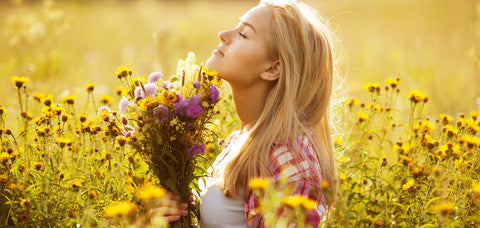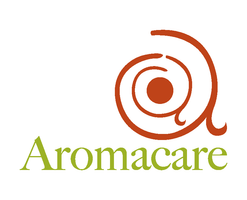
Have you noticed the floral aromas of spring and that extra spring in your step? Do any smells trigger a memory for you? When I smell cinnamon and nutmeg I have memories of my mum’s warm winter rice pudding and the smell of thyme puts me in my Grandmas’s garden and I immediately remember her wonderful food, always full of herbs cooking on the stove. These aromas remind me of my Mother’s and Grandmother’s nurturing and I find them very comforting.
Aromas trigger powerful feelings, emotions and memories. As soon as an aroma is inhaled sensory nerve receptors fire off messages to a part of the brain called the limbic system. The limbic system is in charge of memory and emotions and aromatic stimuli deeply affects our mood and behaviour.

(Derrickson, 2012)
What is Aromatherapy? Put simply essential oils are a concentrated form of a plant which has its own unique chemical composition. Essential oils are derived from the bark, resin, petals, stems, leaves and roots of plants. These plant parts are then usually distilled or cold pressed to extract the essential oils. It is the unique chemical composition of an essential oil that determines its therapeutic actions. For example Tea Tree, like a number of other essential oils, contains terpenes which have both antibacterial and antifungal properties. This makes it a wonderful ingredient in creams and lotions for treating tinea and other skin infections. Lavender essential oil is rich in linalool so has therapeutic effects that decrease anxiety and promote relaxation. (Bowles, 2003)
Aromatherapy has history, it is nothing new, it has been used for thousands of years. Early Egyptians prepared aromatic oils for use in cosmetics, aromatic perfumes and health care products. Hippocrates, an iconic Greek physician in the history of medicine, prescribed aromatic baths for health, and advocated the use of perfume as a soothing and healing remedy. In India aromatic oils are used during Ayurvedic massages for their healing properties and many aromatic plants have a spiritual significance and are used ceremonially. Throughout the history of The Middle East and Europe to the present day there is a great deal of evidence demonstrating the use and value of aromatherapy. For example lavender was used during the First World War to assist in the healing of wounds and Tea Tree oil is used in the same way today. (Battaglia, 1997)
There are many ways to use essential oils. Here are just a few:
To relax and calm: Use 6-8 drops of Tranquillity Essential Oil Blend in your Aromatherapy Diffuser. Alternatively have a friend massage your neck and shoulders using Tranquillity Massage Oil. This blend combines the essential oils of Cedarwood, Frankincense, Rose Geranium, Lavender, Sandalwood to produce a calming and balancing effect on the nervous system.
To ease cold and flu symptoms: Add 6 drops of Respiratory Essential Oil Blend to your Aromatherapy Diffuser. Place the diffuser by your bedside at night to help with ease your breathing. A steam inhalation is another effective way of relieving respiratory symptoms. Use this method to ease nasal congestion, sinusitis, sore throat, coughs and flu. Add 4-6 drops drops to a bowl of approx. 2 litres of very warm water (not boiling). Place a towel over your head, lean over the bowl and breathe in the vapours for 2-3 minutes at a time for up to 10 minutes if possible. Keep your eyes closed during the steam inhalation.
Cautions: Steam inhalations using the method described above is not suitable for young children and babies and they should be avoided if you have asthma or burns to the skin on the face or décolletage.
To Induce sleep: To help you sleep place 3 drops of each Roman Chamomile, Lavender and Marjoram on a tissue and put it into your pillow slip. Or try 6 drops of Sleep-Well Essential Oil Blend in your Aromatherapy Diffuser . The beauty of our diffuser range is that the essential oils are not heated so you get full aromatic intensity from every drop and they turn off automatically once the blend has run down. If you’re lucky enough to have a bath, treat yourself in the evening using 4-5 drops of Sleep-Well in the water. Concentrate on slow deep diaphragmatic breaths as you relax your body.
Bed time for children: Have you ever had trouble putting your kids to bed? Try our Children’s Massage & Body Oil and create a nurturing and relaxing ritual for your family at bedtime. Take a small amount of the oil and massage into the back using gentle hands prior to bed time. The essential oils of Orange and Lavender bring a feeling of contentment, helping kids to relax and unwind.
To get up and go: Have you ever needed to get up and go but don’t quite have the energy? Try the Energising Essential Oil Blend of Cinnamon, Lemon, May Chang, Sweet Orange, Petitgrain and Rosewood. This can be used by applying 6 drops into your Aromatherapy diffuser. These oils have an uplifting and energising effect on the mind and body. Perfect to use when preparing for a party or a night out after a long day at work.
A word of Caution: Essential oils are concentrated forms of therapeutic plants. They should be used sparingly, as directed and never be applied undiluted directly to the skin or taken internally.
References
Battaglia, S. (1997). The Complete Guide to Aromatherapy. Virginia: The Perfect Potion .
Bowles, E. J. (2003). The Chemistry of Aromatherapuetic Oils. Sydney: Allen & Unwin.
Derrickson, G. J. (2012). Principals of Anatomy and Physiology 13th Edition. New Jersey, United States of America: John Wiley & Sons, Inc.
